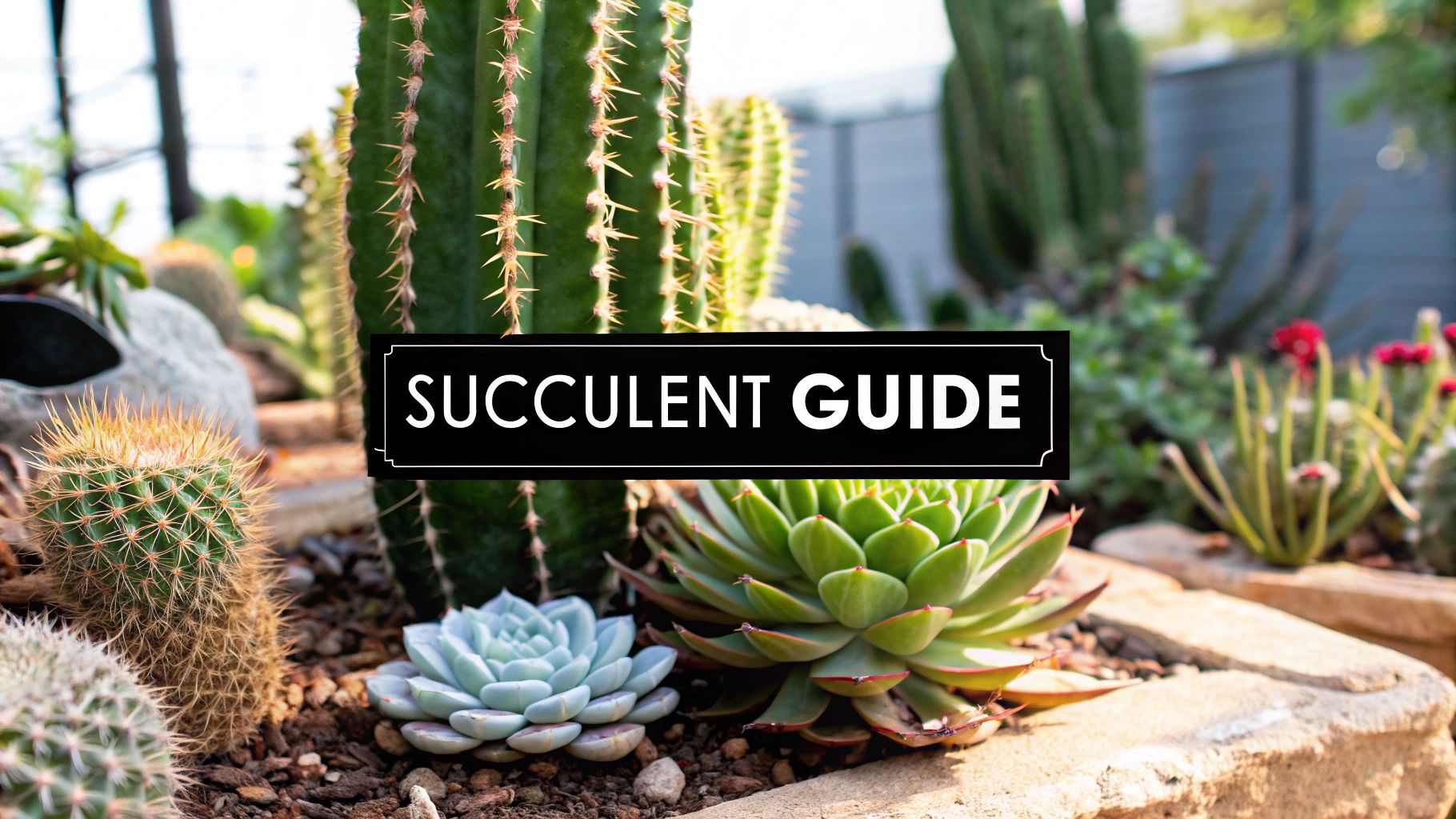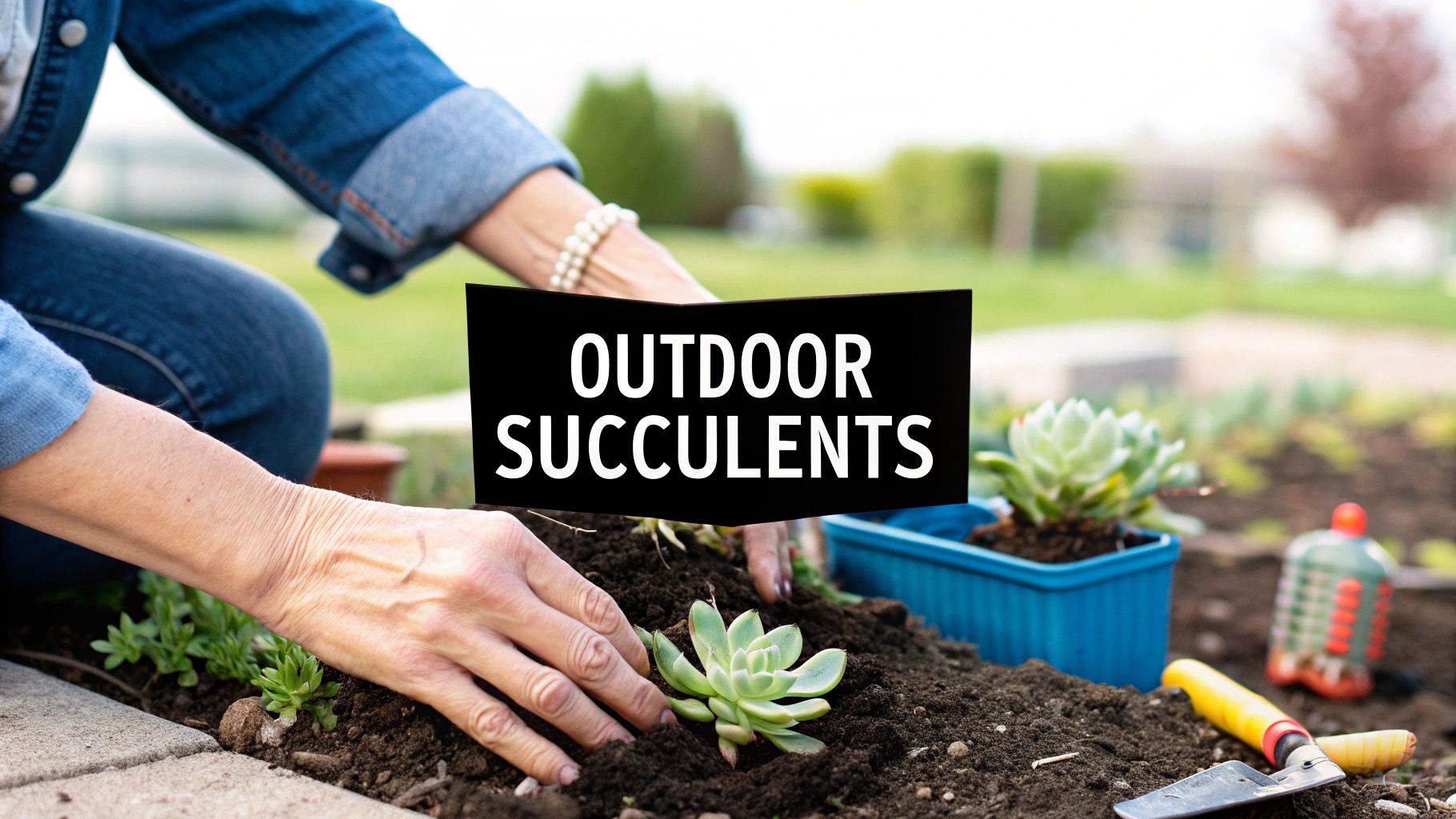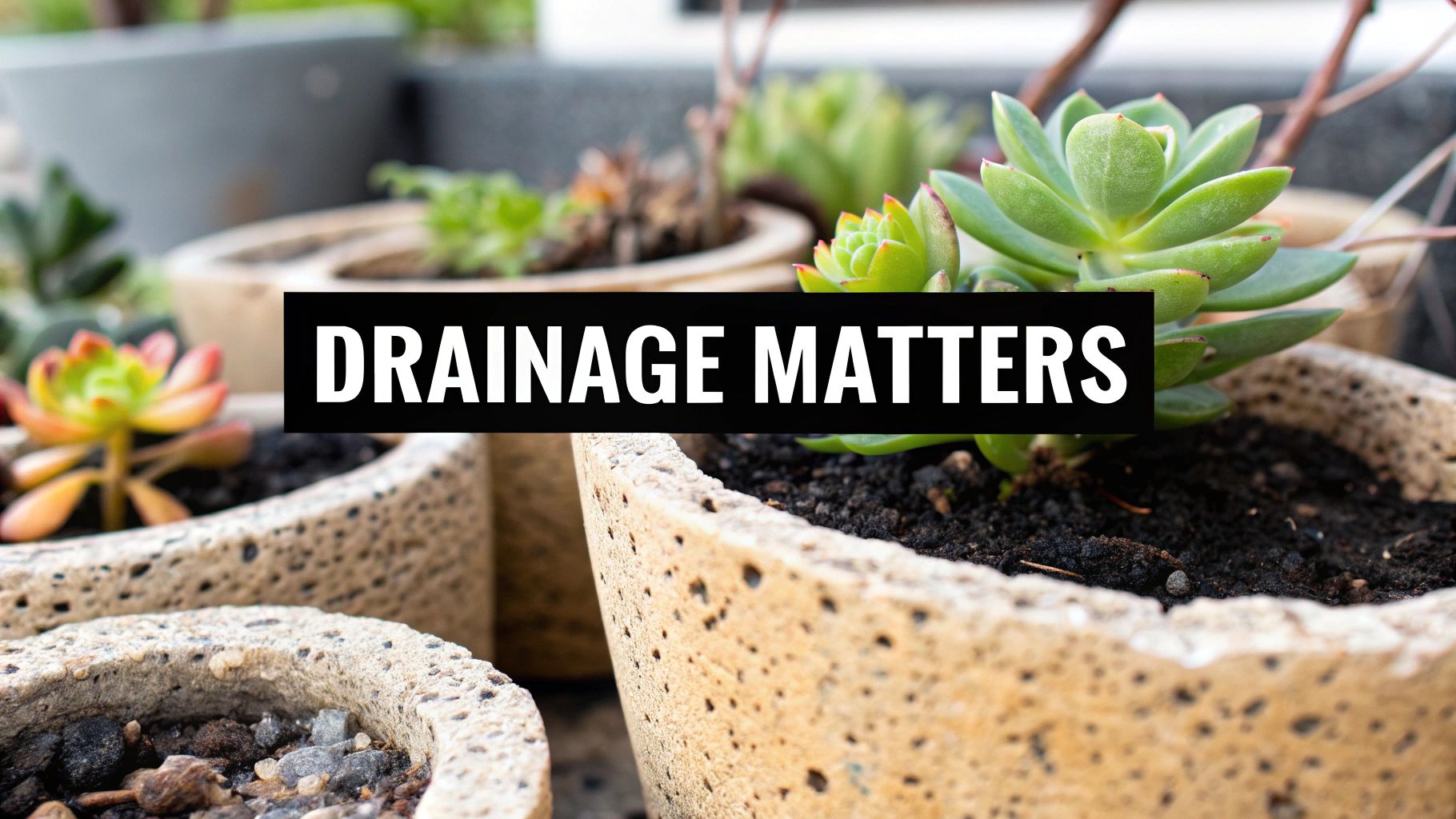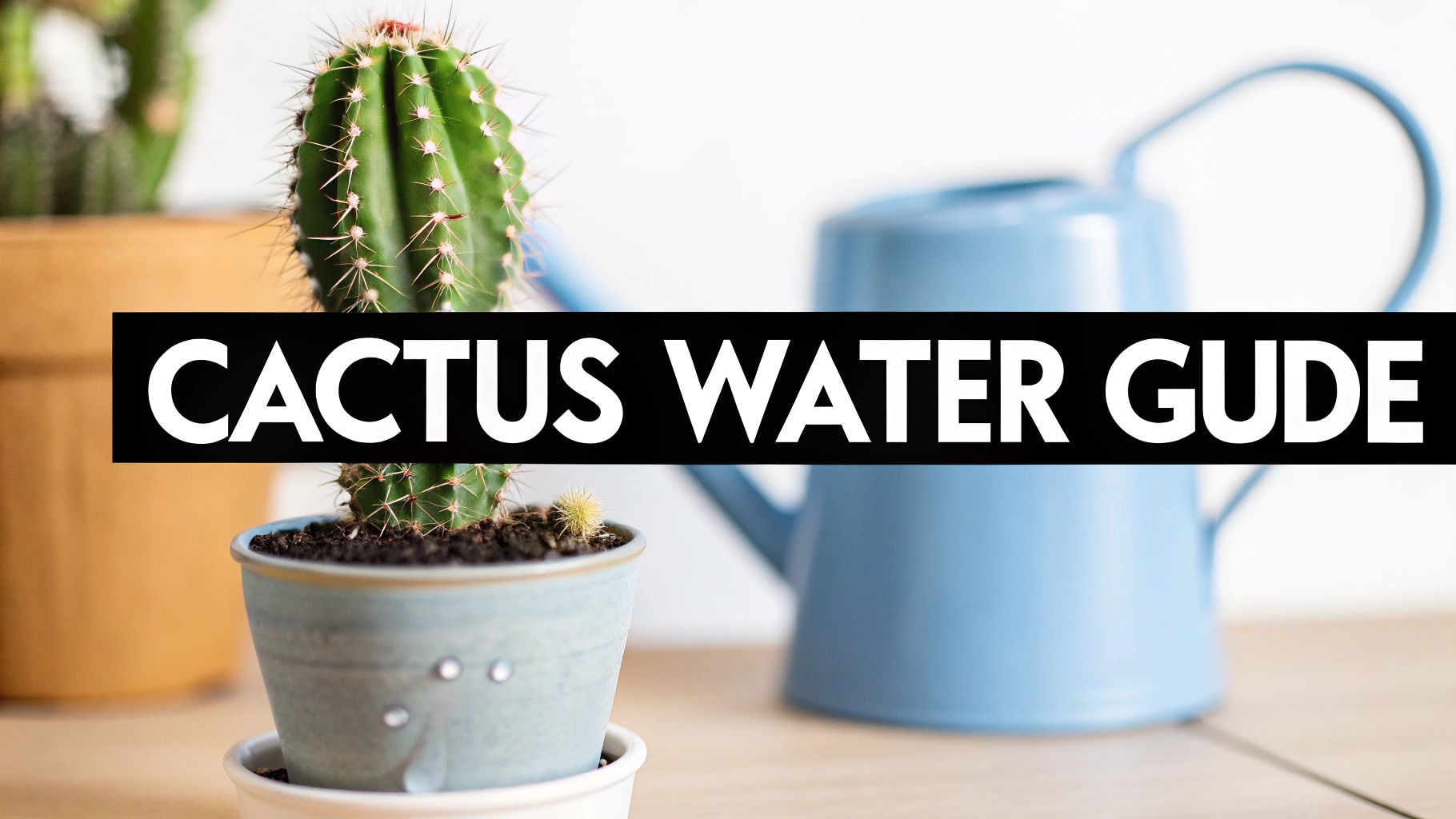Succulents and cacti are some of the most popular and resilient plants you can bring into your home, largely because they can thrive on what feels like sheer neglect. But what’s the difference between them?
It’s a common question, and the answer is surprisingly simple: all cacti are succulents, but not all succulents are cacti. Think of "succulent" as the main category of plants, and "cacti" as one very specific, very popular group within that larger category.
So, What Makes a Plant a Succulent?
The word 'succulent' isn't a strict scientific family name; it's more of a descriptive catch-all. It applies to any plant that has developed special fleshy tissues to store water in its leaves, stems, or roots. This is their survival superpower, allowing them to hang on through droughts and in climates where rain is a rare treat. It's also what makes them such forgiving houseplants for busy people.
This water-storing strategy is found in thousands of species across more than 60 different plant families. This is why you see such a mind-boggling variety of them. You have everything from the classic rosette-shaped Echeverias to the bizarre Lithops that look like colorful pebbles. Many succulents look nothing alike, which can lead to some head-scratching moments. For a great example of this, you might want to learn more about the differences between cacti and euphorbia, which can look eerily similar at first glance.
The Cactus Difference: It's All in the Areoles
If cacti are just one type of succulent, what makes them so special? Cacti are all part of one massive plant family, Cactaceae. The single, tell-tale feature that sets them apart from every other succulent on the planet is the presence of areoles.
Areoles are small, fuzzy, cushion-like bumps on the surface of a cactus. From these little spots, all spines, flowers, and new branches grow. No other type of succulent has them.
This is the botanical smoking gun. If you see areoles on a plant, it’s a cactus. If it doesn't have them—no matter how spiky or tough it looks—it's a non-cactus succulent. Simple as that.
This helpful infographic breaks down the relationship visually.

As you can see, both cacti and other succulents fit neatly under the main "succulent" umbrella. Grasping this simple rule clears up one of the most common bits of confusion in the plant world. It's no wonder their popularity keeps exploding; the global market for these easy-going plants is projected to hit $1.5 billion USD by 2025, all thanks to their unique beauty and low-maintenance charm.
To make it even clearer, here’s a quick table breaking down the key characteristics.
Succulent vs Cactus Quick Comparison
| Characteristic | General Succulents | Cacti (A Succulent Family) |
|---|---|---|
| Water Storage | Yes, in leaves, stems, or roots. This is the defining trait. | Yes, primarily in stems. |
| Defining Feature | Fleshy, water-filled tissues. | Presence of areoles (small bumps where spines/flowers grow). |
| Leaves | Often have prominent, fleshy leaves (e.g., Echeveria, Aloe). | Most have lost their leaves, which have evolved into spines. |
| Spines | Some have spines or thorns, but they don't grow from areoles. | Spines always grow from areoles. |
| Plant Families | Found across 60+ different plant families. | Belong to only one family: Cactaceae. |
| Native Regions | Worldwide, in various arid and semi-arid climates. | Almost exclusively native to the Americas (North and South). |
This side-by-side view really highlights how cacti are a specialized group that follows the succulent blueprint but with their own unique set of rules.
Diving Into the Major Succulent Families
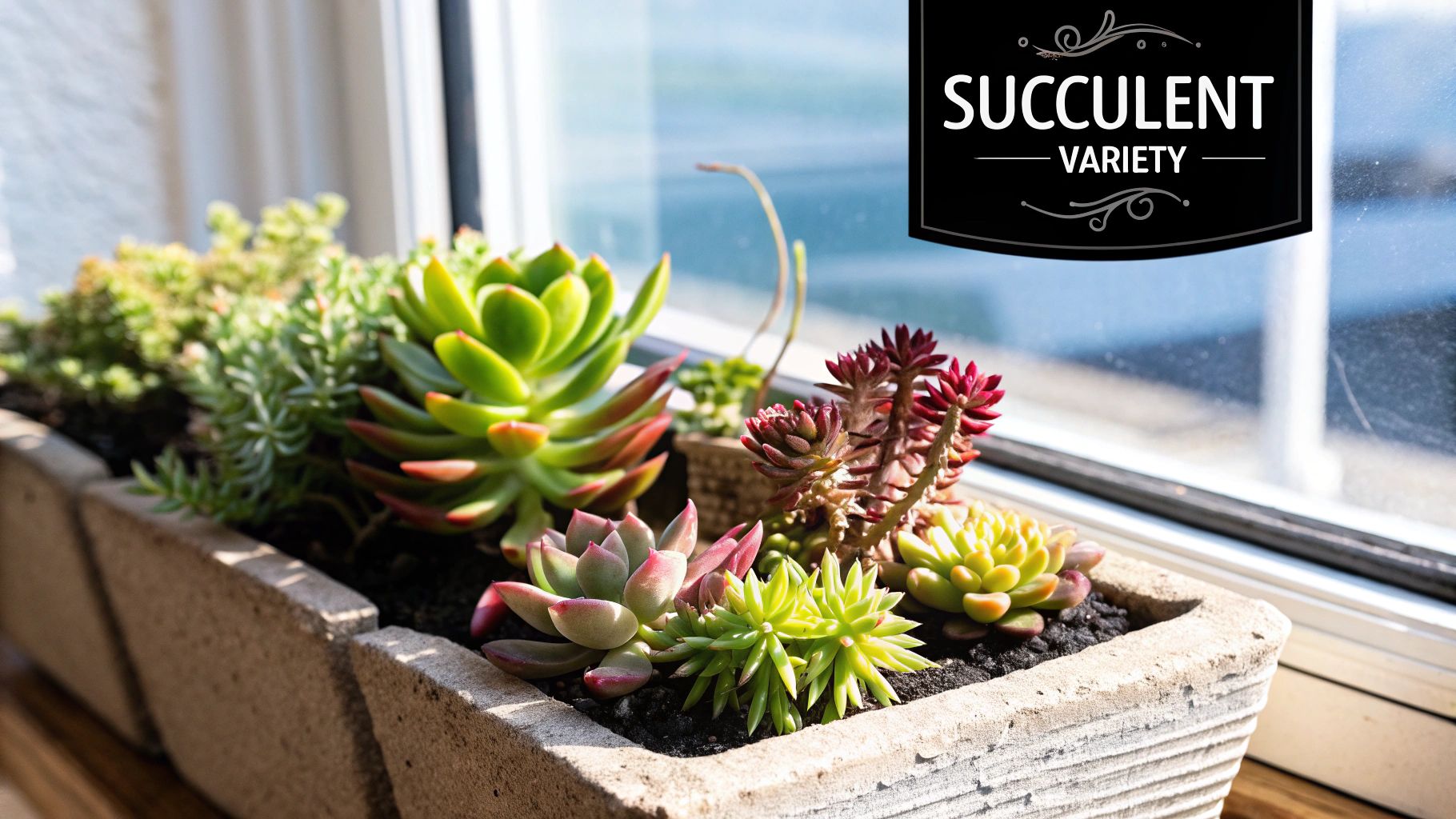
Now that we've got a handle on what makes a succulent a succulent, let's explore the incredible diversity outside the cactus world. I like to think of the succulent kingdom as a massive country. These families are like its major states, each with a unique culture, landscape, and a few star residents everyone knows and loves.
We'll take a tour through three of the most prominent families you're likely to find at any nursery or in a collector's window.
The Crassulaceae Family
This is the rockstar family of the succulent world. Seriously, when most people imagine a classic, picture-perfect succulent with those beautiful rosette shapes, they're almost certainly thinking of a plant from the Crassulaceae family.
It's a huge group that includes so many of our favorites: Echeveria, Sedum, Sempervivum (you know them as "Hens and Chicks"), and Kalanchoe. What really makes them stand out is their almost magical ability to sprout a whole new plant from just a single leaf. This trick makes them a blast to propagate and a collector's dream. The variety here is just staggering, from low-growing stonecrops that act as groundcover to elegant rosettes that look like desert flowers.
The Aizoaceae Family
Next up, let's get weird. The Aizoaceae family is home to some of the most wonderfully bizarre plants you'll ever see, specializing in the art of camouflage. These are the mimicry masters, evolving to look exactly like stones and pebbles to keep from becoming some thirsty animal's lunch.
The most famous members, of course, are Lithops, which literally go by the name "Living Stones." In their native habitats, they are so perfectly disguised you could walk right past them. Their truly unique look and easy-going nature have made them a huge hit with enthusiasts. The demand for these little oddballs is so high that the Aizoaceae family carves out a big piece of the succulent market—the full succulent plant market report has some fascinating details on these trends.
The beauty of the Aizoaceae family is its mastery of deception. These plants teach us that survival in nature can be as much about blending in as it is about standing out.
But it's not just about Lithops. This family also gives us the shockingly bright, daisy-like flowers of Ice Plants (Delosperma) and the quirky, cracked appearance of Split Rock succulents (Pleiospilos).
The Asphodelaceae Family
Finally, we arrive at the Asphodelaceae family, a group known for some of the most useful and architecturally dramatic succulents around. These plants are less about dainty rosettes and more about making a statement with bold, spiky forms. Many of them also happen to be packed with medicinal properties.
Two absolute superstars call this family home:
- Aloe: Everyone knows Aloe vera for its skin-soothing gel, but the genus contains hundreds of species. They range from small, clumping aloes perfect for a pot to massive, tree-like varieties that command a landscape.
- Haworthia: These are gems for indoor growers. Famous for their cool stripes, translucent "leaf windows" that let in light, and compact size, Haworthias are perfectly happy in spots with less direct sun.
While we're on the topic, another plant group that often gets mixed up with succulents and cacti is Euphorbia. Many look so much like cacti it’s uncanny, but they belong to a completely different botanical family with their own quirks. It's worth taking a moment to discover more about the diverse types of Euphorbia so you can spot the differences and avoid common mistakes.
A Deep Dive Into the World of Cacti
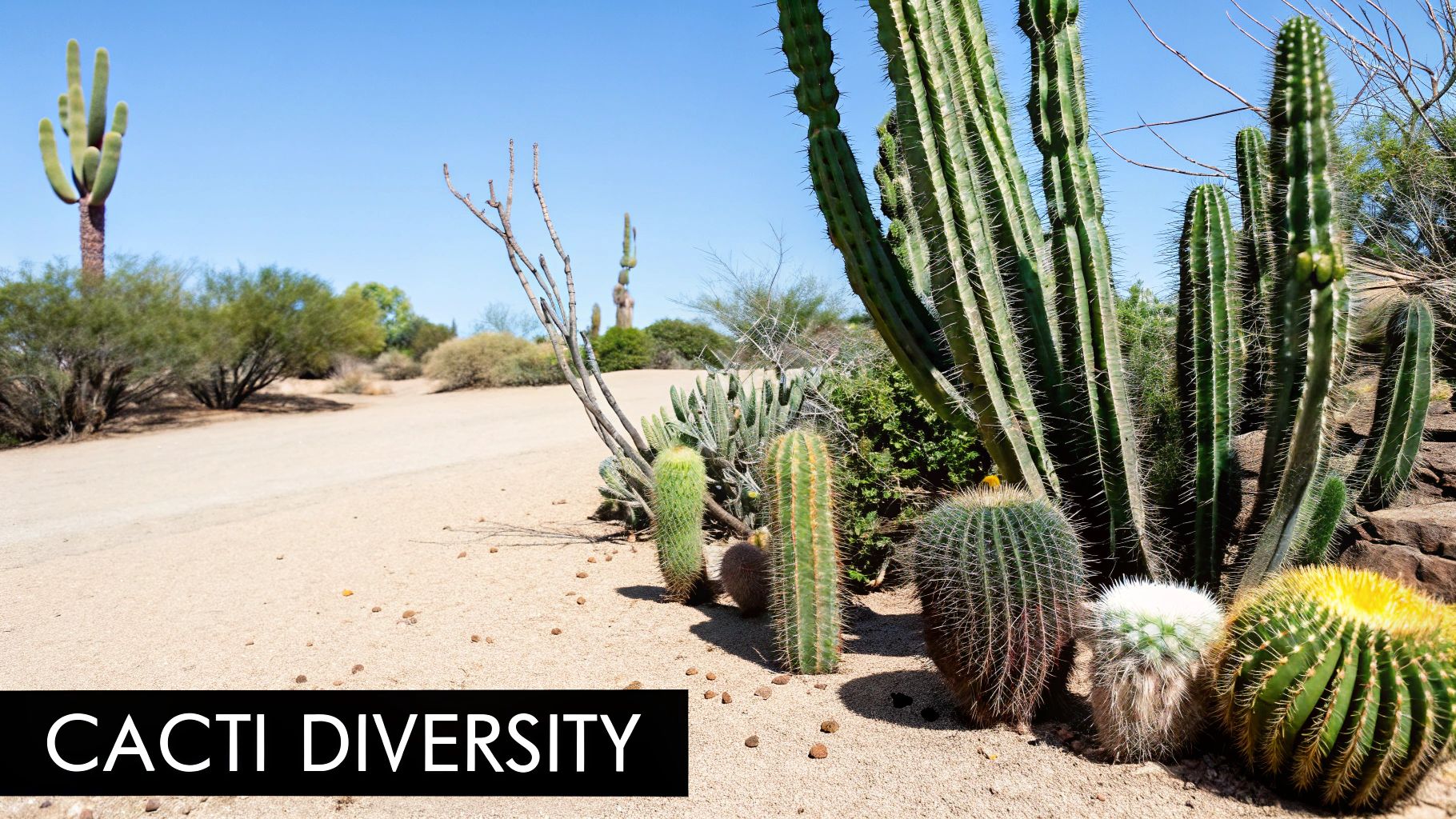
It’s a common saying that all cacti are succulents, but not all succulents are cacti. What truly sets a cactus apart is that it belongs to one very specific plant family: Cactaceae. This family has one tell-tale feature that every single member shares: the areole.
An areole is a small, fuzzy, cushion-like bump on the cactus body. Think of it as a specialized branch—it’s the spot where all spines, flowers, and new stems sprout from. If you can find areoles, you’ve got a genuine cactus on your hands. No areoles, no cactus. It’s that simple.
This single feature is the starting point for an almost unbelievable range of shapes and sizes, far beyond the classic Saguaro silhouette we all know. The number of species is just mind-boggling, something our article on how many types of cacti are there explores in more detail. Getting to know this diversity is the first step in becoming a great cactus parent, because their needs can vary dramatically.
Cacti Categorized by Shape
One of the most intuitive ways to start making sense of the Cactaceae family is by simply looking at their shape. Each form is a masterclass in adaptation, a physical story of how the plant evolved to survive in its native home.
You can group most cacti into a few main categories:
- Columnar Cacti: These are the titans of the cactus world, growing tall and proud like the iconic Saguaro. Their upright form is perfect for soaking up as much sun as possible while protecting the main body from the harshest rays.
- Barrel Cacti: As the name suggests, these plants are built like living water barrels. Their stout, ribbed, and spherical shape is designed for maximum water storage, with accordion-like pleats that can expand when water is plentiful and shrink during a drought.
- Prickly Pears (Opuntia): You can't miss these. They are famous for their flat, paddle-shaped stems, which are actually called cladodes. Beyond their unique look, many Prickly Pears are famous for their edible and delicious fruit.
- Epiphytic Cacti: Breaking the desert mold entirely, these cacti grow on other plants, usually in humid jungle canopies. Species like the beloved Christmas Cactus have long, trailing stems and absolutely love humidity—a world away from their spiny desert relatives.
Desert Dwellers vs. Jungle Cacti
Understanding the difference between a desert cactus and a jungle cactus is probably the most critical lesson for any owner. It can literally mean life or death for your plant.
A desert native like a Barrel Cactus craves intense, direct sun and wants its soil to dry out completely. Put a jungle native like a Christmas Cactus in those same conditions, and it will burn to a crisp. It needs dappled, indirect light and much more moisture to feel at home.
Understanding a cactus's native habitat is the most important step in providing proper care. A plant's shape and origin story tell you everything you need to know about its light, water, and soil requirements.
This incredible variety is a big reason why cacti have become so popular. In fact, the global market for cactus plants was valued at an impressive $3.86 billion USD in 2021 and is on track to hit an estimated $7.01 billion USD by 2025. This explosive growth shows just how captivated people are by the tough, beautiful, and endlessly fascinating members of the cactus family.
Popular Genera for Your Collection
Now that we've covered the major families, let's get to know some of the stars of the show. Think of the plant world like a library: the family is the genre (like science fiction), and the genus is a famous author (like Isaac Asimov). The genera below are the absolute bestsellers you'll find in almost every collection, loved for their beauty, resilience, and unique personalities.
These are some of the most popular types of succulents and cacti to start with or add to your home. Each one brings something different to the table, from classic, elegant shapes to wonderfully strange forms.
Echeveria: The Rosette Royalty
If you’ve ever stopped to admire a succulent that looks like a perfectly sculpted, flower-like rosette, chances are you were looking at an Echeveria. Hailing from Mexico, these plants are famous for their stunning symmetry and a dazzling array of colors—from soft pastel pinks and blues to deep, moody purples.
Echeverias are total sun-worshippers. They need bright light to keep their tight, compact shape and show off their best colors. Without enough sun, they’ll start to stretch out and look leggy, a process called etiolation. For watering, stick to the "soak and dry" method: give them a good drench, then let the soil dry out completely before watering again.
Sedum: The Versatile Groundcover
Next up is Sedum, also known as stonecrop. This is a huge and incredibly diverse group. You'll find Sedums that trail gracefully from hanging baskets, like the famous 'Burro's Tail', and others that form dense, low-growing mats that are perfect for rock gardens or groundcover. Their leaves come in all sorts of shapes, from tiny, bead-like pearls to broad, flat pads.
What really makes Sedum a crowd-pleaser is its toughness. Many varieties are surprisingly cold-hardy, and they are experts at creating new plants from a single fallen leaf. They generally thrive in full sun and, just like Echeverias, absolutely must have well-draining soil to keep their roots happy.
Sempervivum: The Hardy Hens and Chicks
Often mistaken for Echeveria, Sempervivum (a name that means "live forever") gets its common name "Hens and Chicks" from its unique growth habit. A main rosette (the "hen") sends out little baby offsets ("chicks"), which eventually create a dense, spreading colony of plants.
The real giveaway between them and Echeverias is their incredible hardiness. Sempervivums are also monocarpic, which sounds dramatic—it means the hen rosette dies after it flowers—but its chicks carry on the family line. This frost-tolerance makes them a fantastic choice for outdoor gardens, even in colder climates.
Aloe: The Medicinal Marvel
While Aloe vera gets all the fame, the Aloe genus is packed with over 500 species, ranging from small, manageable potted plants to massive, tree-like specimens. Their defining look is their thick, fleshy, spear-shaped leaves, which often have serrated edges and radiate out from a central point.
People love Aloes not just for their striking, architectural look but also for their well-known medicinal uses. In your home, they prefer bright, but indirect, light and need very little water. They are highly prone to root rot, so letting them dry out between waterings is non-negotiable.
Did You Know? Cacti and succulents have been useful to humans for centuries. The pads and fruit of Opuntia (prickly pear) are a food source in many cultures, and Hoodia gordonii was traditionally used by indigenous peoples in South Africa to suppress hunger during long journeys.
Mammillaria: The Pincushion Cactus
Now for a true cactus representative! Mammillaria is one of the largest cactus genera, boasting over 200 species. You’ll probably know them as "pincushion cacti" because of their classic small, round, or cylindrical shapes completely covered in spines. One of their most charming features is the halo of colorful flowers they produce in rings near the top of the plant.
These little guys are perfect for beginners. They stay small, are a breeze to care for, and readily pop out offsets, forming beautiful clusters over time. Like most desert dwellers, they demand plenty of direct sun and very little water to thrive.
Care Needs for Popular Genera at a Glance
To make things even easier, here’s a quick-reference table that breaks down the basic needs of the genera we've just met, plus a few other popular ones you’re likely to encounter.
| Genus Name | Light Requirement | Watering Frequency | Cold Hardiness |
|---|---|---|---|
| Echeveria | Full Sun / Bright Light | Low | Not Frost Tolerant |
| Sedum | Full Sun | Low to Moderate | Varies (Many are Frost Hardy) |
| Sempervivum | Full Sun | Low | Very Frost Hardy |
| Aloe | Bright, Indirect Light | Very Low | Not Frost Tolerant |
| Mammillaria | Full, Direct Sun | Very Low | Varies (Some are Frost Hardy) |
| Crassula | Bright Light / Full Sun | Low | Not Frost Tolerant |
| Haworthia | Bright, Indirect Light | Low | Not Frost Tolerant |
| Agave | Full Sun | Very Low | Varies (Many are Frost Hardy) |
| Opuntia | Full, Direct Sun | Very Low | Very Frost Hardy |
| Gasteria | Bright, Indirect Light | Low | Not Frost Tolerant |
Remember, these are general guidelines. Always check the specific needs of your particular plant, as conditions can vary even within the same genus. Happy growing
Mastering the Essentials of Succulent Care
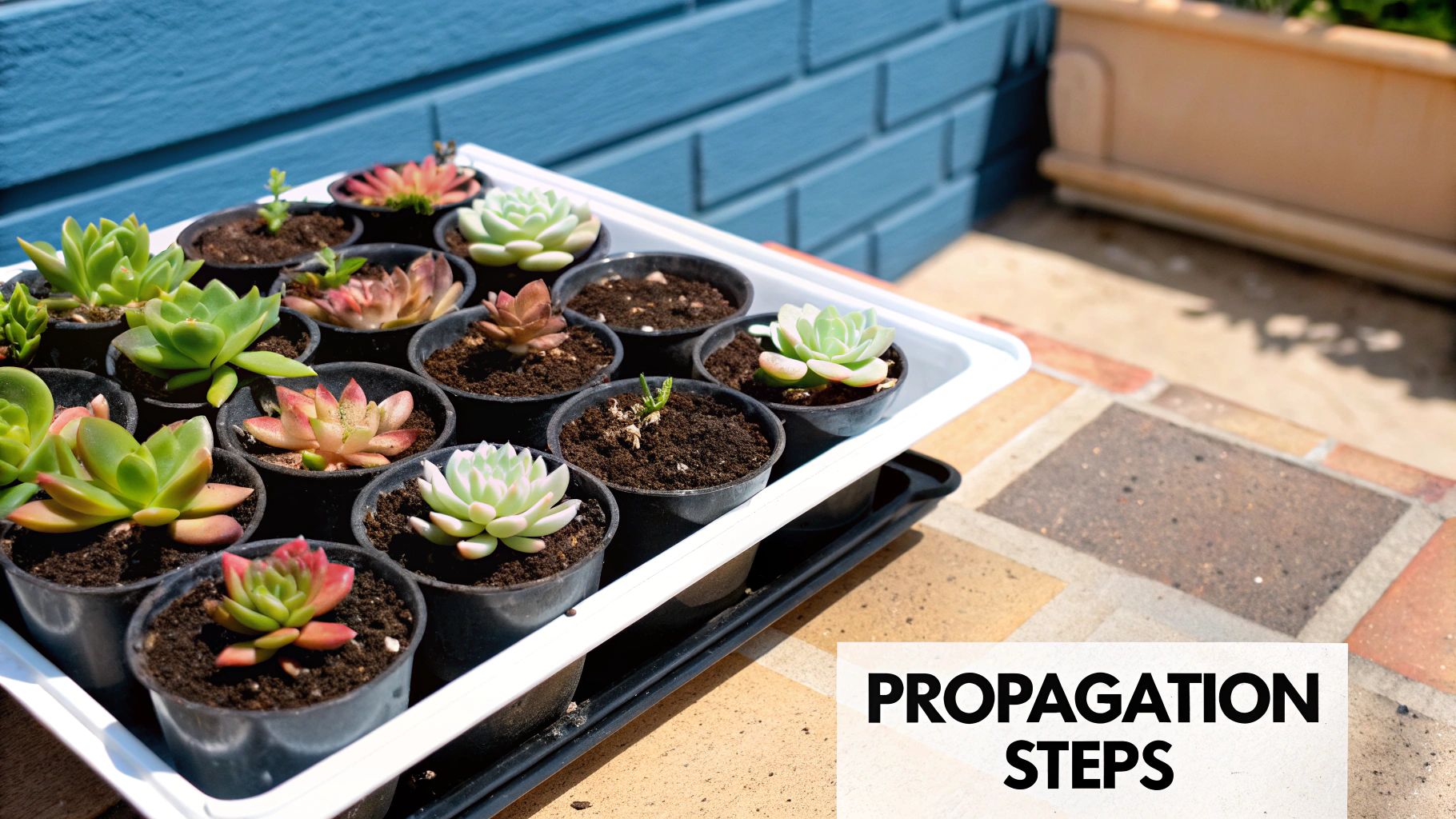
Now that we’ve met some of the key players in the succulent and cactus world, let's get down to what really matters: keeping them happy. The good news is that caring for these plants isn't complicated. In fact, most of them thrive on a simple, consistent routine built around three core needs: light, water, and soil.
The secret isn’t a rigid schedule, but rather understanding why they need what they need. These are plants built for survival in tough places, so our job is simply to replicate that environment as best we can.
The Three Pillars of Succulent Health
Get these three things right, and you're 90% of the way there. Think of them as the foundation of a house—if one is shaky, the whole thing can come tumbling down. When they work together, your plants have everything they need to flourish.
-
Light: Succulents are solar-powered. Most of them need at least six hours of bright, indirect sunlight every day to keep their compact shape and vibrant colors. For indoor growers, a south-facing window is usually prime real estate. If a plant isn't getting enough light, it will start to stretch and look pale and gangly—a process called etiolation.
-
Water: This is the big one. Most people kill their succulents with kindness, specifically by watering too often. The best approach is the "soak and dry" method. Drench the soil completely until water runs out of the drainage hole, then—and this is the important part—let it dry out entirely before you even think about watering again. For most homes, this works out to once every 2-4 weeks.
-
Soil: Your average bag of potting soil is a death trap for succulents. It’s designed to hold moisture, which is the exact opposite of what you want. Succulents need a gritty, fast-draining mix that lets their roots breathe. You can buy a specialty cactus/succulent mix or make your own by adding things like perlite, pumice, or coarse sand to regular potting soil.
For a deeper dive into the specifics, this guide on how to take care of succulents indoors and outdoors is a great resource for fine-tuning your routine for different seasons.
Avoiding Common Beginner Mistakes
Sometimes, knowing what not to do is just as valuable. New growers often learn the hard way that these plants don't appreciate being coddled. Sidestep these common pitfalls, and you’ll be ahead of the game.
Without a doubt, the number one killer is overwatering. It’s an easy mistake to make, but it leads to root rot, which is often a point of no return.
Remember the golden rule: "When in doubt, let it dry out." A thirsty succulent can almost always be saved. A rotten one cannot.
Another classic error is planting in a container without a drainage hole. Cute as that pot might be, if there’s nowhere for excess water to go, it will pool at the bottom and suffocate the roots. Always, always choose a pot with a hole.
Finally, remember that not all succulents are the same. A desert cactus that loves baking in the sun has very different needs from a jungle cactus that prefers dappled light. Pay attention to the specific plant you have, give it the right light, mimic its natural watering cycle, and plant it in the right soil. That’s the simple formula for success.
Common Questions About Succulents and Cacti
When you're first getting into succulents and cacti, a few questions always seem to pop up. We've all been there! Getting a handle on these common issues is often the key to helping your collection really take off.
Think of this as your go-to troubleshooting guide. We'll walk through the most frequent hurdles and help you figure out what your plants are trying to tell you.
How Can I Tell if My Succulent Needs Water?
The best way to know for sure is to check both the soil and the plant's leaves. The golden rule here is to wait until the soil is completely dry, not just on the surface, but all the way down. An easy trick is to stick a wooden chopstick or skewer deep into the pot—if it comes out clean and dry, it's watering time.
Your plant will give you signals, too. Thirsty succulents often have leaves that look a little wrinkled, deflated, or feel soft to the touch. When they're happily hydrated, their leaves should be firm and plump. After you give it a good soak, you should see those leaves fill back out within a day or so.
A word of advice: never water on a strict schedule. A plant's needs change with the seasons, the amount of light it gets, and even the humidity in the air. Always check the soil first!
Why Are My Succulent Leaves Falling Off?
Losing leaves is a classic sign that your plant is unhappy, and the most common culprit is overwatering. If the roots are sitting in soggy soil, they can start to rot. Once that happens, the plant can't take up water or nutrients, and it will start shedding leaves—which often look mushy, yellow, or even translucent—as a cry for help.
That said, severe underwatering can also cause leaf drop. A plant that's parched might sacrifice its oldest, lowest leaves to conserve water and energy for new growth. And of course, some leaf loss is totally normal as the plant ages. The trick is to feel the soil and look at the fallen leaves to figure out what's really going on.
Can I Grow Succulents and Cacti Indoors?
Absolutely! Plenty of succulents and cacti are perfectly happy to live indoors. The single most important thing you can give them is enough light. To keep their vibrant colors and compact shapes, most will need at least six hours of bright, indirect sunlight every day.
A spot near a south-facing or west-facing window is usually your best bet. If your home is a bit on the darker side, don't worry—a simple grow light can make all the difference and open up a whole new world of plants you can grow. For really low-light spots, try starting with tough-as-nails genera like Haworthia, Gasteria, or the jungle-native Schlumbergera (Christmas Cactus).
Here at The Cactus Outlet, we're passionate about helping everyone succeed with these incredible plants. Take a look through our extensive collection of healthy, high-quality cacti and succulents to find the perfect new friend for your home or garden.

